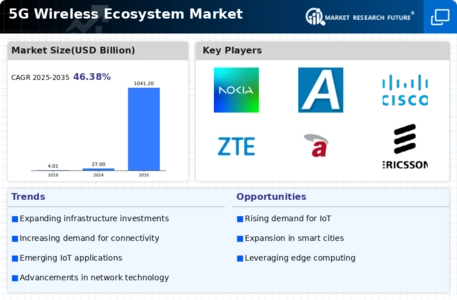Emergence of New Business Models
The emergence of new business models is reshaping the 5G Wireless Ecosystem Market. Companies are exploring innovative approaches to monetize 5G services, such as network slicing and subscription-based models. These models allow for tailored services that meet the specific needs of different industries, from healthcare to entertainment. The potential revenue from 5G services is estimated to reach $700 billion by 2030, highlighting the lucrative opportunities available. As businesses adapt to these new models, they are likely to drive further investment in 5G infrastructure and services. This evolution not only benefits service providers but also enhances customer experiences, positioning the 5G Wireless Ecosystem Market for sustained growth.
Growth of Edge Computing Solutions
The growth of edge computing solutions is significantly impacting the 5G Wireless Ecosystem Market. By processing data closer to the source, edge computing reduces latency and bandwidth usage, which is essential for applications requiring real-time responses, such as augmented reality and industrial automation. The edge computing market is projected to reach $15 billion by 2025, indicating a strong alignment with the capabilities of 5G technology. This synergy allows businesses to leverage the full potential of 5G networks, enhancing operational efficiency and enabling innovative applications. As more organizations adopt edge computing, the 5G Wireless Ecosystem Market is likely to expand, driven by the need for faster and more reliable data processing.
Surge in Demand for High-Speed Connectivity
The 5G Wireless Ecosystem Market is experiencing a surge in demand for high-speed connectivity, driven by the increasing reliance on digital services across various sectors. As businesses and consumers seek faster internet speeds, the adoption of 5G technology is becoming imperative. According to recent data, the number of 5G subscriptions is projected to reach over 1.5 billion by 2025, indicating a robust growth trajectory. This demand is not only limited to urban areas but is also expanding into rural regions, where enhanced connectivity can facilitate economic development. The proliferation of high-definition video streaming, online gaming, and remote work solutions further fuels this demand, positioning the 5G Wireless Ecosystem Market as a critical enabler of modern communication and commerce.
Advancements in Telecommunications Infrastructure
Advancements in telecommunications infrastructure are pivotal to the growth of the 5G Wireless Ecosystem Market. The deployment of advanced network technologies, such as small cells and massive MIMO, enhances the capacity and efficiency of 5G networks. Recent investments in infrastructure development are estimated to exceed $300 billion by 2025, reflecting the commitment of telecom operators to upgrade their networks. These advancements not only improve service quality but also reduce latency, which is essential for applications like autonomous vehicles and real-time data analytics. As infrastructure continues to evolve, the 5G Wireless Ecosystem Market is likely to witness increased competition among service providers, ultimately benefiting consumers with better services and pricing.
Integration of Artificial Intelligence and Machine Learning
The integration of artificial intelligence (AI) and machine learning (ML) technologies into the 5G Wireless Ecosystem Market is transforming how networks are managed and optimized. AI and ML can analyze vast amounts of data in real-time, enabling predictive maintenance and enhancing network performance. This integration is expected to reduce operational costs by up to 30% for telecom operators, as it allows for more efficient resource allocation and fault detection. Furthermore, AI-driven applications, such as smart traffic management and personalized content delivery, are becoming increasingly viable with the capabilities of 5G networks. As these technologies continue to evolve, they will likely play a crucial role in shaping the future of the 5G Wireless Ecosystem Market.


















Leave a Comment